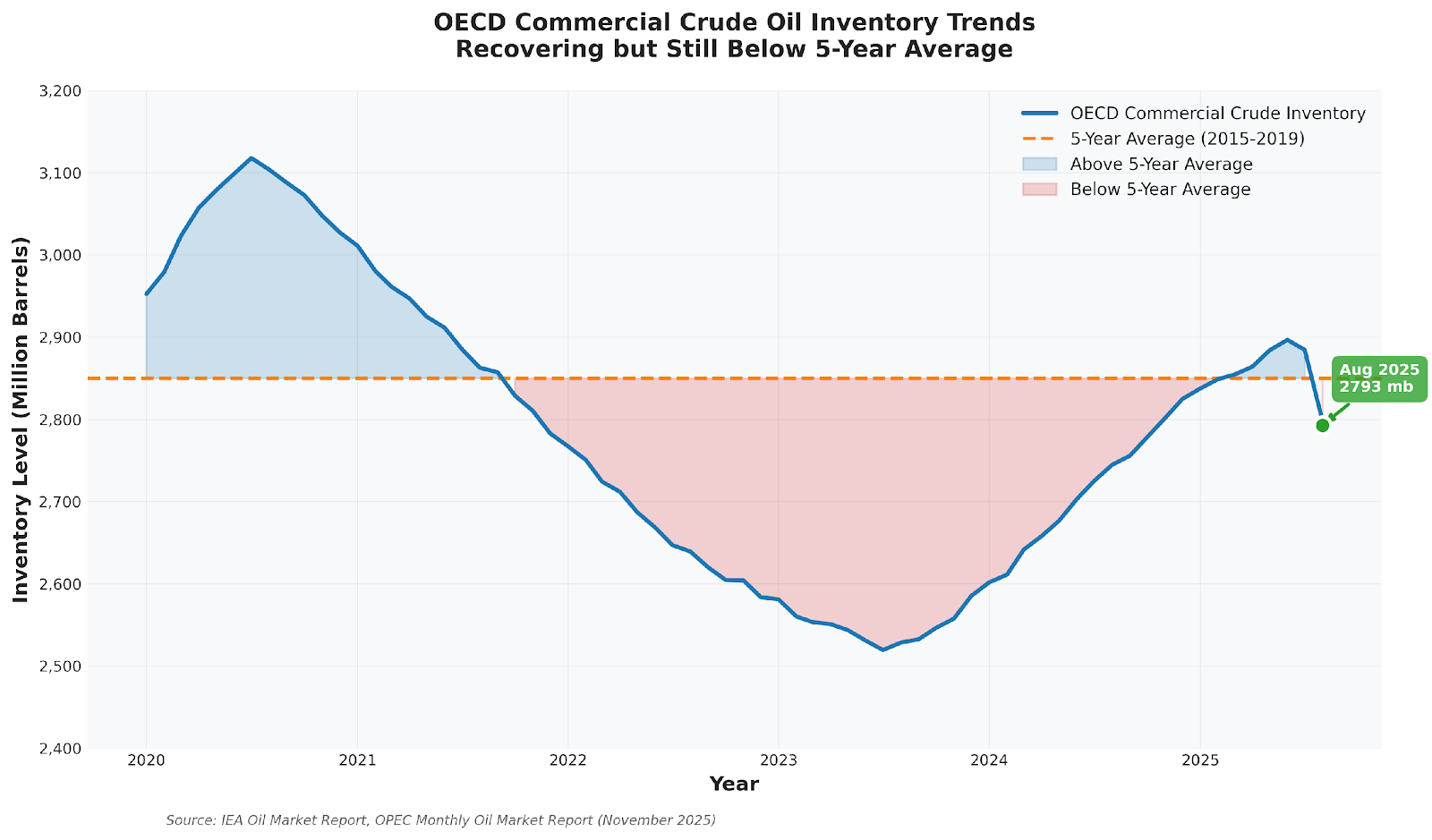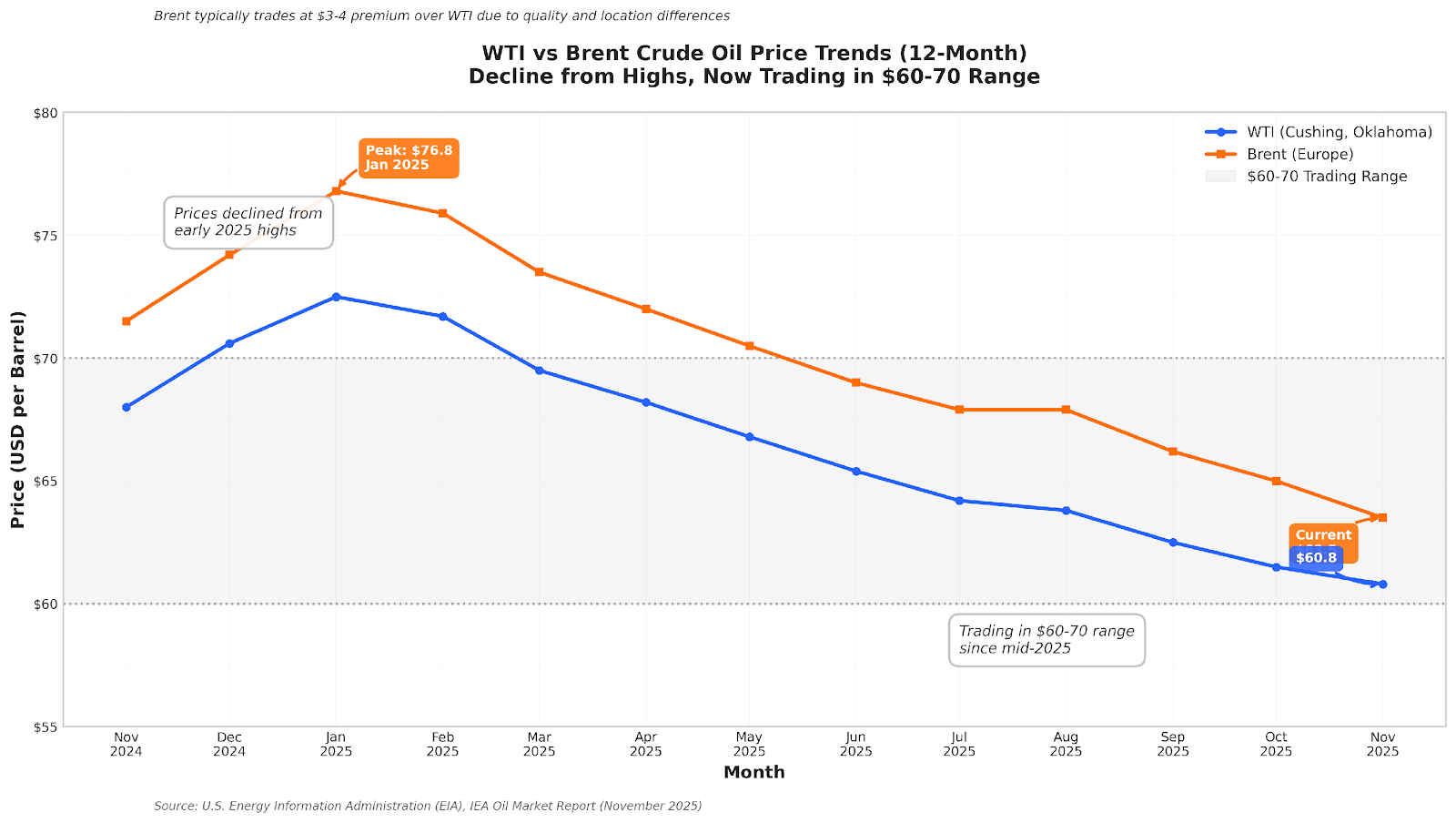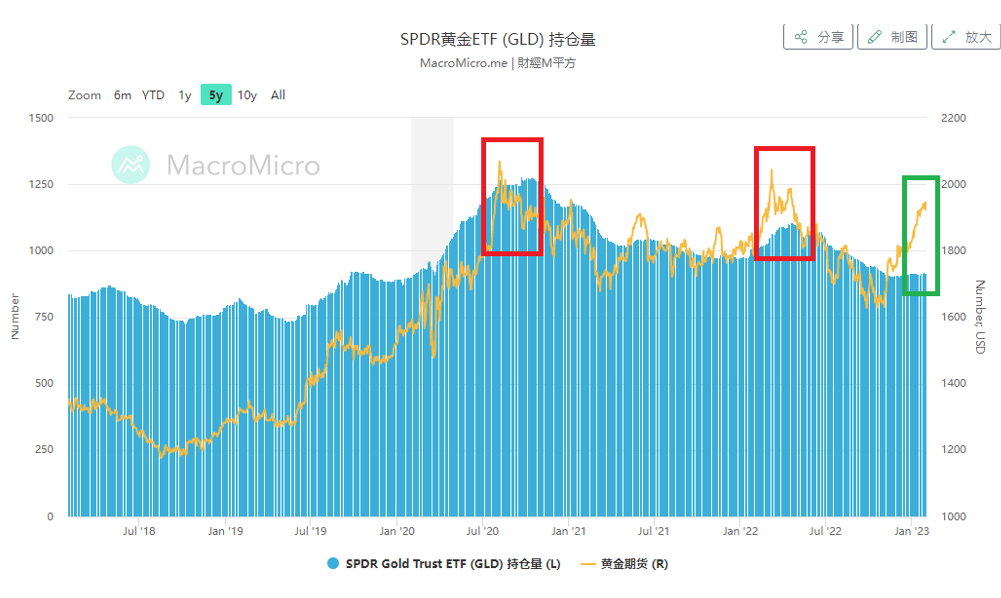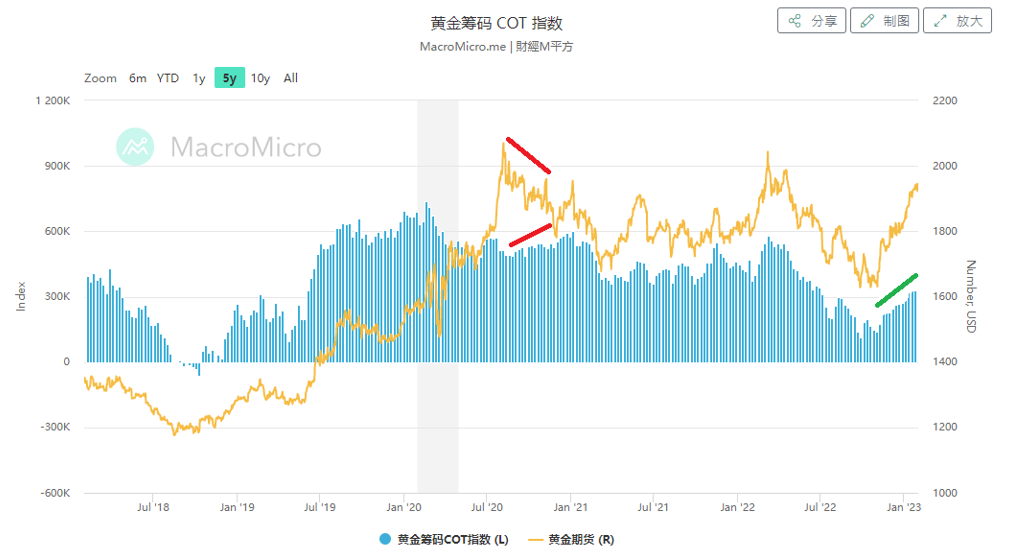市场资讯及洞察
.jpg)
摘要
IEA 最新月报显示,全球石油需求增速放缓但仍具韧性。尽管库存持续回升,但 OECD 库存整体仍低于五年均值,市场对供应中断高度敏感。OPEC、IEA、EIA 均上调非 OPEC 供应,未来可能出现“松中带紧”的供需结构。原油价格在供应宽松预期与地缘扰动之间反复震荡,波动率下降但敏感度上升。油市表现也可能通过风险偏好外溢至能源板块、商品货币及相关市场。
一、全球原油供需前景:IEA 月报核心要点
国际能源署(IEA)最新原油月报显示,全球石油需求虽较去年降温,但整体依旧保持韧性 [1]。先进经济体消费表现好于预期,有效抵消部分新兴市场的疲弱需求。IEA 预计 2025–2026 年全球石油需求将保持温和增长。然而在供应方面,如果 OPEC+ 维持当前产量政策且需求不出现明显下滑,全球石油市场未来数个季度可能重新进入“边际紧平衡”状态。IEA 同时指出,高油价、全球经济放缓、电动车渗透等因素正在逐步压制需求增速,使油市呈现出“短期紧平衡、长期温和宽松”的结构。
二、多机构观点对比:OPEC、EIA 与 OECD 数据
三大机构对于未来市场平衡的看法存在显著差异,这主要源于对非 OPEC+ 供应增长和需求韧性的不同假设。总体来看,市场普遍认同未来供应将更加充裕,但对于过剩的规模和时间点存在分歧。

图 3:三大机构对 2025-2026 年需求与供应增长的预测对比,显示供应增长普遍超过需求增长,预示市场将进入供应过剩周期。
OPEC 的观点相对乐观。OPEC 预计 2025 年全球石油需求将增长约 130 万桶/日,2026 年略高至 140 万桶/日 [2]。与此同时,OPEC 在最新报告中连续上调非 OPEC 供给预期,并首次将 2026 年市场从“短缺”调整为“小幅过剩”,反映其判断未来供应增长可能快于需求。
EIA 的判断更偏向供应充裕。EIA 上调了美国页岩油产量预测,指出 2025 年美国原油产量将创历史新高。同时,全球供应预期被上调至日均 1.06 亿桶,高于全球消费的 1.041 亿桶,意味着未来库存可能持续累积 [3]。EIA 预期 2025–2026 年库存增加将对油价形成中期压力。
OECD 库存虽然持续回升,但仍低于五年均值。IEA 数据显示,今年全球观测库存前八个月净增约 2 亿桶,但 OECD 商业库存仍比五年均值低约 6700 万桶。整体来看,库存虽然恢复,但仍处历史偏低区间,使油市对供应中断的敏感度依旧很高。

图 1:OECD 商业原油库存近 5 年对比最新水平,显示库存虽有回升但仍低于五年均值。
三、原油价格走势:WTI 与 Brent 如何消化预期
2023 年下半年,布伦特因供应紧张和地缘冲突预期一度突破每桶 90 美元。然而进入 2024–2025 年,随着供应回升和库存恢复,油价整体震荡下移。近期价格承压主要来自供应过剩预期强化以及美国库存意外上升。

图 2:WTI 与 Brent 价格从 2025 年初的高位回落,近期在 60–70 美元区间震荡。
尽管地缘事件偶尔推升价格,但反弹难以持续,因为供应宽松的结构性预期迅速重新主导市场。WTI 与 Brent 的期限结构一度出现小幅 Contango,显示短期供应充裕压制近端价格,而远月因长期需求预期而保持相对坚挺。整体来看,油市呈现低波动、弱趋势但对消息高度敏感的特征。
四、驱动油市的关键变量:地缘政治与供应端不确定性
运输通道风险仍是油市最大的潜在冲击点之一。全球三分之一海运原油经过霍尔木兹海峡,一旦受阻便可能引发油价剧烈波动。衍生品定价显示断供概率虽低,但属于典型的“低概率、高冲击”事件。
OPEC+ 的政策滞后性也带来结构性波动。减产会压低库存、推高价格,但高油价又刺激非 OPEC 增产,使市场重新宽松。美国页岩油增速放缓进一步加剧供应端的不确定性,削弱其作为“摇摆产能”的角色。此外,俄罗斯、伊朗等国因制裁和冲突导致出口波动,更加剧油市敏感性。
五、油市变化的外溢影响
能源板块通常与油价同方向变动,但反应速度较油价更平缓。油价对风险偏好的溢出效应也容易影响澳元等商品货币。大宗商品价格上行往往提升商品出口国的贸易条件与风险情绪,而价格下跌则可能压制相关货币表现。
六、原油市场风险提示
- 数据发布风险: EIA 每周库存、IEA 与 OPEC 月报可能导致短线波动。
- 地缘政治风险: 产油区冲突、海运通道中断、制裁变化均可能影响供需平衡。
- 宏观风险: 利率政策、美元走势及全球经济增速变化都可能改变需求前景。
结语
IEA 最新展望显示,全球油市进入“边际紧平衡”阶段:库存修复但仍偏低,供应端不确定性大于需求端。在这种结构性环境下,油市会对政策、地缘事件与供给变化表现出高度敏感。理解供需框架、关注库存趋势与识别关键风险,将是未来判断油市走向的关键。
参考资料
[1] IEA (International Energy Agency). (2025, October). Oil Market Report - October 2025. https://www.iea.org/reports/oil-market-report-october-2025
[2] OPEC (Organization of the Petroleum Exporting Countries). (2025, November). Monthly Oil Market Report. https://publications.opec.org/momr
[3] EIA (U.S. Energy Information Administration). (2025, November). Short-Term Energy Outlook. https://www.eia.gov/outlooks/steo/


Chart patterns (e.g. head and shoulders, triangles, double bottoms/tops), are commonly used to assist in trading decision making. If using these as part of your entry approach, their use should be viewed as a specific strategy, amongst others you may use, and so merit a dedicated section within your plan. This article outlines some of the key things to consider when writing and using such in your trading plan.
General rules with trading plans revisited The statements within your trading plan serve two primary functions, as discussed in detail in previous articles. It is important that such statements are specific enough to more effectively perform these functions, namely: a. Facilitate consistency in trading action e.g. in the entry and exit of trades, allowing the trader, and b.
Enable measurement e.g. within a journal, to make an evidence-based judgement on how well these statements are serving you through testing. With this level specificity, it is easier to ‘tweak’ components rather than throwing the “baby” of any strategy “out with the bathwater”. Often, many experienced traders discover the finer details can make a relatively big difference to trading results, rather than massive changes in approach.
Obviously, if there is a lack of consistency, originating from behaviours that move away from what you have planned, make it almost impossible to make any judgement on the success, or otherwise, of a strategy. Using chart patterns adheres to all the above. What about trading chart patterns?
Chart patterns are simply a representation of potential changes in market sentiment. Often combined with other indicators and can be used to indicate a potential entry into, or in some cases exit from, a specific position. Some patterns indicate a trend reversal (e.g. head and shoulder, double tops, triple bottoms etc), others a pause (congestion) before continuing in the direction of a previous trend e.g. flags, pennants, symmetrical triangles.
Patterns may occur on any timeframe but generally speaking are more robust (in terms of potential longevity of movement) on longer timeframes (although of course they cannot indicate with any accuracy how long that move may be). As with any entry approach, there is a chance that a trading idea based on an identified pattern will fail and so, as always, appropriate risk management should be put in place And within your trading plan? Chart patterns are not easily identifiable with most general indicator systems and are often best “sighted” so there is an element of subjectivity.
Logically this could suggest that this makes it even more vital to be robust in your description of how to use these in your trading. We have identified FIVE potential components to include within your written trading plan. These are: 1.
Your definition of the chart patterns you are going to use 2. When you are going to use them 3. Identification of when a pattern is completed 4.
Other factors you may use to potentially decrease the chance of a false breakout from any chart pattern you are going to use 5. Your initial stop placement method #1 Your definition of the chart patterns you are going to use Specify which of the chart patterns you are choosing to trade. Ideally, a description of what this pattern looks like on a chart will help lock this in.
For example, if we were to describe a double top it could read: • Reversal of upwards trend. • Creation of two upwards prongs. Around the same price level forming a ‘M-shape’. • Breakout below the ‘confirmation point’ (bottom of “prongs” confirms reversal. #2 When you are going to use them There are two perhaps obvious, and yet important, factors to include: a. On which timeframes you are going to use chart patterns b.
The proximity of impending economic data releases. For example, If trading a 30 minute chart you could specify “no relevant (define this e.g. specific to currency pair, sector of share CFD), significant (define this e.g. you may decide to actually state the data points) data due within the next 3 hours. #3 Identification of when a pattern is completed Experienced traders always wait until a pattern is complete before acting. However, the incidence of false breakouts (i.e. when a trading idea fails after a pattern is completed) is worth taking steps to attempt to limit.
Let’s use the break of a neckline on a ‘reverse head and shoulders’ as an example. Clearly, price moving upwards through the neckline is the desire. However, you need to articulate what are you using to determine this.
E.g. At any time within a candle period or on candle close price; and/or is there a specific distance such as using 0.5 ATR, or perhaps number of pips/points, above the neckline? #4 Other factors you may use to potentially decrease the chance of a false breakout from any chart pattern you are going to use The following may be considered: a. Which other indicators e.g. moving average, volume b.
Intra-candle price action e.g. close within the top third of the candle if considering a long trade. c. Agreement on other timeframes (although this may not be the pattern what constitute “agreement” e.g. price above 10EMA. d. Minimum distance to next “key price point” e.g. next resistance price level if going long. #5 Your initial stop placement method As the structure of each pattern is different then it is important to specific your initial stop placement methods for each.
So, to use the previous example, if trading the “idea” of a breakthrough a neckline, a pre-planned exit logically could be move back through that neckline may indicate a trade failure and necessitate a risk management exit (and so of course be a determining factor in your position sizing into that trade). As with defining what constitutes a breakout, logically again, you need to specify whether you are using an anytime touch of a price for exit or a candle period close price, and/or is there a specific distance (an how you are going to articulate this) below the neckline. So now to action… Depending on where you are now with you plan there are two potential actions. 1.
If you are already using chart patterns use the above checklist to determine whether you have these components included, fill any gaps and that ensure they are specific enough 2. If you have not got part of your trading plan them this may help you get started in making it happen Remember of course, the above is indicative suggestions only, it is YOU that must make the choice about what to include/not include and the specific parameters you are going to test and ultimately use.


In previous articles we have discussed in detail the merits of a trading journal in offering evidence for both: a. How well you are following a trading plan? b. How well your trading system is serving you? (assuming you are already following a trading plan) We have also outlined the importance of “closing the circle” and making sure you review journal data and action plan to make any amendments that would be of benefit.
If you are in the position that you have “jumped in” and made a trading a journal a reality in your trading, next level journaling aims to increase the quality of information, where you can optimise those things you are doing well and work on those things that need improvement. This, in essence, is all to do with asking the right questions of the information you have, so you can continue to make evidence-based judgements as to what type of trading suits you best. The reality is that no two traders are the same (even if using a similar system).
Your challenge is to find YOUR best approach that works for YOU. And subsequently, mirror this on an ongoing basis. Here are THREE potentially “game-changing” questions you could ask of your journal data which may give clues about “best fit” behaviour for you as an individual. #1 Which trading direction works for me?
There is no doubt that some traders have results that seem to be better going “long” and others trading “short”. The other possible outcome, of course, is that it doesn’t matter, and you perform equally as well irrespective of direction. Measuring the results of long versus short trades will give you this answer.
Let’s assume there is a noticeable difference. After obtaining this evidence your choices are twofold. The root cause of this may either be: a.
You have a simple aptitude for trading in a specific direction and so can mirror this with all future trading. b. It may be that your system works well for going in one direction and needs adjustment with the other. In this case, provided you are not comfortable sticking to (a) above then of course you have the evidence to refine that part of your system that appears to require adjustment. #2 Which timeframe works for me?
Similarly, we can look at whether specific timeframes work better for you as an individual trader. Questions about optimum timeframes are some of the most frequent that we receive on both ‘Inner Circle’ and the ‘First Steps courses. We have written about this topic before, the conclusion being that it is your individual circumstances that are most likely to dictate which timeframe works best for you.
Again, the power of a journal is that you can easily come to an answer, and so mirror that going forward (of course, this is dependent on you recording this as part of your journal process). #3 Which trading vehicle suits my trading style? Many of you reading this may be trading multiple vehicles e.g. Forex, Index CFDs, Share CFDs, commodities, options.
There are obvious differences not only in how these various instruments are priced but also influencing factors on how they move. Using a similar approach to the above, you can easily identify which vehicles are working for you. As with exploring trading direction the reason for this could be your characteristics as a trade or the robustness of your system in trading different vehicles.
So, the choices are the same - you can allocate a larger proportion (or even all) of your capital into trading the vehicle that produces better results or of course review and tweak the system for those vehicles with less desirable results. OK, so these are your three starting questions, that may help you find a trading style that is best fit for you. However, before we finish, it is worth offering a couple of additional pieces of guidance when doing an exercise such as this. a.
You need a critical mass of trades to make the data meaningful. (there is little evidence that can be gained from a couple of trades in any category). There is no definitive number to what this may be but logically perhaps 15-20 will suffice in the first instance. b. Compare like with like.
To make things meaningful you need to reduce the number of actors that may skew your results. As a start point it would make sense to: i. remove any trades where you clearly didn’t follow your plan, ii. Unless analysing #3 above it would seem logical to compare within one trading vehicle e.g. just your forex trades.
Finally, we would love to hear your feedback on journaling and how it has/has not worked for you (or even problems) you have had getting started. Drop a line a [email protected] with any feedback you would like to share.


A trading edge is a certain approach or special system techniques that, in theory, gives a trader some type of advantage over other market participants, hence making a trader more likely to achieve positive trading results. Many are cynical about the objective of creating a trading edge, despite the plethora of articles and books on various trading techniques. According to them because many traders may learn and apply this same information, the chances of it providing an edge for any individual trader are limited at best, if not non-existent.
Although logically, on the surface, this may seem like a reasonable critique, in much the same way as searching for the “holy grail’, this statement is more than questionable for reasons: a. The assumptions underpinning this thinking are essentially flawed. b. There are traders (although perhaps in the minority) who create positive trading outcomes on a consistent, sustainable basis.
This is indicative of the definition of a trading “edge”. Let’s look at these in more detail. Challenging flawed assumptions Although it is correct that many trading techniques are written about and taught, in reality why most of these do not work are either because: a.
System issues – Most people fail to develop a comprehensive, sufficiently specific system that facilitate consistency in action when entering or more commonly exiting a trade. If this is crucial in order to implement any technique, then it is the absence of this rather than the technique that is a major impacting factor. b. Behavioural issues – Even with the above in place, it is commonly recognised that many traders fail to follow through on such systems.
We have written about this in other articles extensively and it likely most traders have discipline issue when trading in the “heat of the action”. Again, a failure to execute is a major contributing factor rather than any technique. c. A failure to measure and adapt a system as an individual trader – Again this is a common theme in the articles we publish.
Any business, including your “trading business” is best served through formal measurement (e.g., in a journal as well as the “accountancy” information). It is only through this that we can identify: i. How well or otherwise you are following your system ii.
Whether some components of your system would benefit from some amendment to better suit you as an individual trader. So, if most traders suffer from any or all of the above, then the assumptions that all traders have a robust system that as required for an edge is essentially incorrect. And successful traders?
We have suggested previously that in any field, those who succeed do the things that most people do not like/fail to do. The three issues covered in the previous section are more commonly NOT embraced and adhered to by most traders, and it appears as though these are common characteristics by those consistently successful traders that we aspire to be. The reasons for traders not to embrace these are many, but it boils down to a basics e.g., required education or failure to take trading seriously enough, or invest the effort to do the “hard yards” (it is human nature to look for short cuts).
Arguably therefore, even without looking a special trading technique “a” versus technique “b”, if accepting that the three components discussed above are beneficial, is part of what can make a successful trader. Actioning ALL of these is what most traders don’t do and making these happen could give you an advantage over other market participants - this is your possible trading edge. And finally The result of actioning the above in total, and with reference to the third component of trading measurement is you will be able to begin to objectively compare system versus system.
It is quite simple. In summary, Is it possible to create a “trading edge” and give you a potential advantage over other market participants? Well the very fact that most traders don’t do what they need to, as we have discussed above, could theoretically give you that “edge”.
This is your starting point and then take it to the next system versus system testing level.


In a previous article we addressed the concept of cognitive trading biases as a barrier to potential successful implementation of a trading plan in the heat of the action you “press the button” on entry or exit action. This article discussed these biases - “loss aversion” which you can read here ( click to read ). In this article we examine another common cognitive trading bias, termed minimalisation bias.
Trading biases revisited People have inbuilt set of belief and value developed outside the trading context but when the trader interacts with the market, these individual natural ways of thinking and feeling become part of decision-making. Some of these natural in-built responses may not serve you well and are termed ‘cognitive biases’ which may take over from your written and planned ‘trading system’ and become the major influence on your market behaviour. Recognising that these exist and developing awareness of whether one or some of them are part of your trading psychology is the first stage in addressing any bias.
The aim of this series is to help explain what they are, and you are able to make the judgement on your market interaction. What is a minimalization bias? Logically, good decisions in any context (including trading of course) are based on having complete and accurate information, to enable us to process this, and subsequently take appropriate action.
In a trading context, we have access to not only information relating to market sentiment, and tools (indicators) that can help us make sense of this, but also resources that may indicate terms of increased risk e.g. economic data release dates and times. Ideally, the way we use this information both for entry and exit should be specifically articulated within a trading plan which acts as a guiding light for action. In simple terms, many plans will have a set of criteria, or checklist, that if all can be ticked off as present, then act e.g. trade entry can be taken.
With a minimalization bias, the trader basis their decisions on small amounts of usually incomplete information, or in other words, act when all of the criteria have NOT been met. What happens with a minimalisation bias? This bias often leads to premature entry and exit before a full set of signals are confirmed.
Common examples of this may include low trading volumes, not keeping an eye an eye on the economic data release, attempting to predict the next price move often seen when acting on immature candles or bars, or before there is confirmation of a breakthrough a key price point. Commonly, such errors originate from time pressures, poor charting techniques, a lack of specificity in trading instructions within a plan or a lack of, or skipping looking at, appropriate resources to help inform decisions. When in an open trade we may see action (e.g. exit) without substantial evidence of a weakening price, retracements often used as exits rather than clear reversal signs.
The impact of this is limiting the profit potential of a specific trade. Trying to ‘bottom pick’ at the market (if looking for a long trade) may also be a problem in more severe cases, where the investor believes the price had stopped going down on a slow down on the drop rather than waiting for a clear reversal signal. Remember, an exit signal is not necessarily a reason to trade in the opposite direction.
Overtrading due to poor entries, followed by rapid exits may also be a symptom. What you can do if you think you may have a minimalisation bias? If this resonates with you, then the purpose of this article is fulfilled, as recognising and “owing” that there is something that needs to be addressed.
It is the VITAL first step in making a change. Obviously, there are steps you can take to address this (and you MUST). Here are some suggestions: a.
You have a complete trading plan that articulates trading actions both for entry and exit. The more specific these are, the less likely you are to stray. Make sure EVERY one of your criteria is crystal clear. b.
Record and review in your journal how you are feeling as you trade and the market circumstances during your decision-making. It would be rare that this bias is present in every trade. Through recording this information, you may be able to see common thread as to when this bias raises its ugly head.
Armed with this information you will then be able to either avoid trading in certain circumstances, or simply “checking yourself” a little more rigorously. Sometimes the very process of formally recording what you are doing helps in doing the right thing more consistently. c. Re-align with your trading plan prior to every trading session, remind yourself prior to looking at the market what your key criteria for action are. e.
Take regular breaks from the market during any session, particularly when trading shorter timeframes, to re-align with purpose and plan and avoid over-emotional trading. f. If you are in a position where you are finding information difficult to access, then simply ASK. There are many out there with those resources not only at hand but also how to get that information efficiently.
Finally, as we finished when we discussed “loss aversion” as you work on this please be gentle on yourself in terms of your development. Biases by nature are usually deeply ingrained and will take some work to address.


Warning: Turn your sensitivity meter down a little. This is a no sugar-coating, tell-it-how-it-is article (but rest assured it comes from a nurturing place). All over the globe, trading gurus attempt to sell their wares (software, the ‘holy grail’ of trade set ups etc) using retrospective charting examples.
Such powerful visual “evidence” is often used to persuade prospective FX clients that this vehicle is ‘easy’ to make profit with. With little work, little time, or whatever marketing buttons they are using to press to get a response. So, hours of energy invested, often cash is exchanged and yet more often than not, with an off the shelf system in place (often just an entry system which we know is never going to offer a complete trading solution) traders are left feeling more than a little disappointed that such “guaranteed, easy riches” are not showing up in their trading account.
On an individual level we see similar. Much airplay is given to the merits of back-testing and yet as with the aforementioned guru approach, you can just about find examples, if you look hard enough, of chart examples that mean this “next new indicator thing” is now the answer to replenish your now depleted finds. So, what happens, we have a system change, and yet results still often fall short of expectations.
There are 3 common dangers of the retrospective approach to creating (if you haven’t a trading plan already) or altering an existing plan that are worth highlighting. #1 – Overstating the function of back-testing. Let us be completely blunt. The purpose of back-testing is NOT, nor should ever be viewed as evidence that a trading plan, based on what ever system you are exploring, will work for you in the reality of live trading.
Back-testing does not generally consider: a. The impact of economic data releases and revisions, b. The political and general climate both globally and specifically in the countries that currency pairs relate to, c.
Individual investor behaviour re. timeframes, time of day that they trade, nor their ability (or otherwise) to act or inaction on a change of sentiment, d. Unplanned events such as escalating conflict (or the threat of such), e. The relationship and impact of other financial instruments of FX pairs e.g. equity and bond markets, commodities So, why back-test at all if the evidence could be so flawed?
The answer is simple, back-testing creates evidence, not that a system will definitely work for you as a trader, but ONLY as evidence that a forward (or prospective) test may be worthwhile. So, the bottom line is the function of back-testing is to justify the time and effort to prospectively test. It is after such a prospective test that system changes can be made/developed. #2 – Failure to gather a critical mass of evidence There are two issues here. a.
What constitutes enough evidence to move to the next stage of system testing. Quite often traders will make decisions on a limited amount of data e.g. one timeframe and one currency pair, over the last couple of months on which to make system decisions. Now you have read this it may seem obvious and may not need pointing out (but we will anyway) why this is insufficient information on which to base a “cross the board’ entry and exit system. b.
The second issue here is one of selective evidence gathering. A natural human response when excited by an idea is search for evidence to back up that idea. The potential danger with this is that we often tend in this search, to ignore information that refutes our idea. #3 – The reason behind doing this may not be that your system is failing rather it could be a YOU issue.
System skipping is common amongst many traders and is invariably motivated by results that are not as desired. Here is the danger. As much of what goes into creating trader results (some would suggest up to 80%) is due to behavioural issues (we have waxed lyrical about trading discipline previously) unless you: a.
Have a trading plan that is specific, measurable and comprehensive AND b. Follow it religiously ‘to the letter” then you are not really in a position to make a judgement on whether system could serve you well or is likely not to produce desired results. AND to add to this, as such behavioural issues have not been either acknowledged or addressed whatever system (based or retrospective charts or not) is more likely to produce equally disappointing results.
So, before you start on the journey of altering a system you should logically make every effort to have, follow and measure the impact of any system before you even consider changing it (or looking into what you may change it to). This MUST be your #1 priority before going down any path of system alterations. So there you have it.
You have a choice to take action of course on what you have read, If so, your missions going forward are: a. Make sure you have a comprehensive plan that you follow. Then, and only then, should you begin to explore further development including the use of retrospective charts (or back-testing) b.
Recognise the SOLE PURPOSE of back-testing is to create evidence that a forward (or prospective) live test is justified. c. Make sure you are basing any potential system change on a enough “balanced” data.


热门话题
其实大众做交易投资除了要会看基本的K线外,还可以学会运用筹码面发现资产在市场上的多空走势,就像技术分析原理也认为:成交量才是唯一不会骗人的指标。今天我们还是来研究世界终极货币的黄金,昨日XAUUSD往下调整到1900位置又回升到1928美元,和我预测的支撑位丝毫不差。但是过程太过刺激,我们还是来研究下机构筹码,吃吃定心丸来看市场吧。给大家介绍两个非常重要有用的指标:SPDR 黄金ETF持仓量和黄金筹码COT指数。

一、SPDR 黄金ETF持仓量SPDR黄金ETF是全球最大的黄金ETF基金,由World Gold Trust Services(世界黄金信托服务公司)及道富环球投资管理于2004年11月在纽约证券交易所推出,是全美首个以商品为主要资产的交易所买卖证券,并成为增长最快的交易所买卖产品之一。该指标极具参考价值,持仓规模越大,代表市场越偏向多方,金价也越容易升高。复盘过去5年的SPDR 持仓量和黄金期货价格走势,可以发现目前市场上黄金的持仓量没有大幅增加,意味着没有过度超买。我们的参照物是之前的历史高点。黄金目前价位为1943美元每盎司,距离10个月前的2070美元峰值不到6%的距离。但是截至昨日,SPDR持仓量为917吨,远低于那时的1067吨,更是与2020年8月历史高点的1268吨相去甚远。因此,这可能暗示金价中长期看还有一定的上涨空间。

同时,我们在图表上还有另一个发现,那就是这个持仓量反映会滞后于价格变化,比如当价格已经触及上述两个前期高点并转而下行,但是持仓量还是会再上升一段时间,只有等空头信号明确后量才会开始下降。在长期趋势的判断上黄金ETF的持仓变化通常很具前瞻性,而对行情的短期走势或震荡行情则无法给出指向。但这个不妨碍我们可以得出这样一个情形的结论:目前持仓量处于平稳抬升,后市价格还会上行一段时期,伴随着持仓量的上升。当量达到阶段峰值后,中长线再看空黄金也为时不晚,因为大趋势交易本身就很难卖在最高点避免资金回撤。二、黄金筹码COT指数黄金筹码COT 指数= COMEX黄金期货大额交易者投机者净头寸- 避险者净头寸筹码面指标代表市场上投资人资金的布局。黄金筹码COT 指数向上代表大型交易者对黄金市场看多,向下则表示看空。与持仓量指标的适用长线和偏滞后性有所不同,复盘过去5年的黄金筹码COT指数和黄金期货价格走势,可以看到COT指数比较多时候表现过于灵敏,常常在价格还未到顶部的时候,指数就早些开始下行了,更加偏于投机性。另一个发现是,大部分时候两者趋势一致,但是偶尔会出现显著背离。比如2020年8月到2021年1月的这个阶段。

体量上看,截至昨日净投机头寸为33.82万合约(1合约等于100盎司),远低于2022年度峰值的58万、2019年9月的65.7万和2020年历史峰值的73.9万。所以结论也是目前价格上涨,但是市场上黄金的净投机头寸没有大幅增加,和持仓量指标指向的结果一致,后市应该金价还会伴随头寸的上升而上涨。可以看出,当前头寸呈持续上升,并未出现拐头,因此大众不宜过度和过早看空。需要注意的,市场是多空博弈结果,坚持多空观点同时价格出现阶段性调整都是正常的。如果黄金处于新的牛市,调整会将是温和的。看了上述两个指标,没有必要担心黄金过于超买或黄金多头过于旺盛。如果金价的调整幅度超过预期,或者调整时间过长,那只有是基本面发生了负面变化,比如2023全球经济确认避免了衰退。免责声明:GO Markets分析师或外部发言人提供的信息基于其独立分析或个人经验。所表达的观点或交易风格仅代表其个人;并不代表GO Markets的观点或立场。联系方式:墨尔本 03 8658 0603悉尼 02 9188 0418中国地区(中文) 400 120 8537中国地区(英文) +248 4 671 903作者:Jack Lin | GO Markets 新锐分析师

